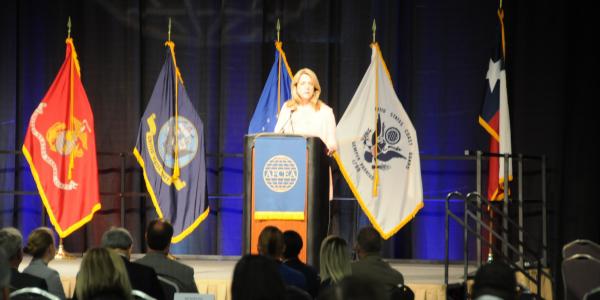Cyber Risks, Op Tempo Taking Toll on Air Force
AFCEA TechNet Air 2016
The SIGNAL Magazine Online Show Daily, Day 1
Quote of the Day:
"Our military's technological superiority is being challenged in ways that we've never experienced before, and we can't take these developments for granted. If we do, that could put American lives at risk in the not-too-distant future."—Air Force Secretary Deborah Lee James
The secretary of the Air Force’s candid assessment of the U.S. military’s declining superiority was not anything that hasn’t been uttered before. And yet, her words rang eerily poignant and ominous, given today’s ever-increasing global instability.
“Our military's technological superiority is being challenged in ways that we've never experienced before, and we can't take these developments for granted,” Deborah Lee James said during her keynote address to kick off AFCEA International’s inaugural three-day TechNet Air 2016 symposium in San Antonio. “If we do, that could put American lives at risk in the not-too-distant future.”
As such, innovation tops James’ list of priorities, particularly in the cyberspace domain, she said. “Cyberspace is increasingly becoming a contested domain and it's critical that we make ongoing investments today, as well as for the future.”
Next month, the Air Force promises to roll out “game-changing” capabilities that will provide real-time identification and eradication of malware, James revealed, though she did not share details. Additionally, the service has initiated research projects to secure avionics software and maintenance systems that she said will be vital to aircraft operations.
The Air Force today spends roughly $4 billion on cyber, with the majority going toward operating the network. “Regrettably, the bulk of our budget is not spent on defending the network or shoring core missions from cyber attacks, or on developing the types of offensive strategies we are going to need increasingly in the future,” James said. “We need to shift resources from enterprise systems to warfighting systems.”
The service has allocated $672 million in fiscal year 2017 to advance both defensive and offensive initiatives, she said.
To that end, the Air Force is teaming with or borrowing from a handful of Defense Department programs to rapidly inject cyber solutions. It will rely heavily on the Defense Innovation Unit Experimental, or DIUx, designed as an innovation hub linking high-tech companies and startups in Silicon Valley with the Defense Department. “Basically, this team on the ground out there is going to help communicate our most challenging national security problems to the innovators and entrepreneurs who don't normally do business with us,” she said. “They'll serve as matchmakers between ideas and opportunities and help those companies who are willing to give us a try to navigate through the DOD system.”
Additionally, the Air Force has failed to train its cyber warriors in strategic thinking, the secretary said. “We need to kick that up a notch.”
To reverse its lack of investment to train its work force in critical thinking in the cyber arena, the Air University at Maxwell Air Force Base stood up a cyber college, where airmen now learn from leading cyberspace strategists, she shared. The Air Force too established the Cyberspace Innovation Center at the Air Force Academy to help cadets develop similar strategic thinking skills.
All great programs—once recruits join.
But the military needs to entice today’s youth to join, she said.
A few programs might accomplish the task, James offered. For one, the Air Force improved its recruiting programs at all levels and implemented creative approaches to attract people, “especially a certain category of high-end programmers and thinkers,” she said. And recruiters now can use an expedited hiring authority to bring in technical talent at a much quicker pace. The service has been using some of the authorities since October 2014, and has added slightly more than 1,600 highly specialized employees to its rosters.
Also, mirroring a wider federal program, the Defense Department launched its Defense Digital Service, or DDS, to lure individuals from leading private sector tech companies who take a leave of absence and work for the military on a temporary basis, James said.
The Air Force is restructuring its active duty work force and developing a much greater reliance on industry to take over some of the IT and defense aspects of network operations, said Maj. Gen. Jerry Harris, USAF, vice commander of the Air Combat Command at Langley Air Force Base in Virginia. “Today, we have a manpower shortfall defending our core missions in cyber. About 85 percent defend the Air Force network. [A reorganization] will hopefully move some of that manpower of defending systems closer to the weapons systems. How we will get there is a challenge.”
That would help redirect airmen attention to core missions, particularly after more than a decade of high operational tempo and combat missions in Iraq and Afghanistan that have taken a toll on the U.S. Air Force, the secretary said. “This is a joint fight, this is a coalition fight, but our United States Air Force has shouldered the lion’s share of this effort,” she said.
And there is no rest for the weary. A resurgent Russia continues to cause problems in Ukraine; recently announced its intent to modernize nuclear weapons; and “of course they the complicated the picture in Syria: they are withdrawing except for when they are not withdrawing,” James said.
“We observed North Korea conduct an illegal nuclear test and a rocket launch within the last month or so, and if all of this is not enough, we continue to see some very worrisome Chinese activity in the South China Sea.”
So what is the service to do?
James delivered the quintessential music to the ears of a conference center packed with industry representatives: “Because the world of cyber changes so quickly, we have got to speed up our acquisition processes,” she said, her words met by a few “amens” from attendees. “We have an industrial era acquisition process while we're trying to compete in an agile digital world.”
The Air Force recently launched Bending the Cost Curve, a series of initiatives complementary to the overall Defense Department’s program known as Better Buying Power. With a goal to cut costs, deliver innovation and cut the amount of time required to acquire a new system, the Air Force is tapping open systems architecture, or OSA, specifically designed to accelerate the acquisition process by using special authority provided by Congress to create novel business structures otherwise not possible under the standard regulations, James said.
“I'm not suggesting that we could use the such a vehicle to build the next generation aircraft, but I do believe that for smaller types of technology insertions and enterprise cyber capabilities, this is the type of direction where we need to move.
“We can't entirely ever let go on network operations, obviously, because our mission depends on it," James said. "But somehow, we have to do better. I'm convinced that leveraging the private sector is part of the key.”






Comments